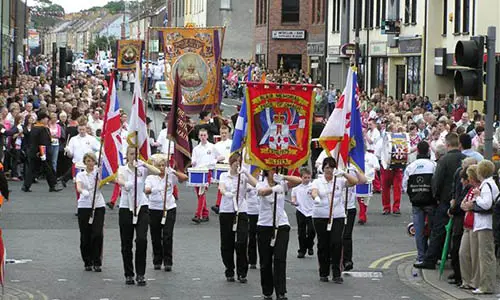1. Orangemen’s Day is celebrated in Northern Ireland, and some parts of Canada on July 12th . It is celebrated by members of the Orange Order, which is a Protestant group.
2. This day is also called the Twelfth, the Glorious Twelfth or Orange Day.
3. Orangemen’s Day has its historical moorings in Northern Ireland, when it was colonised by Protestants from Britain. King James II was a Catholic, and antagonised the Protestants. After the Glorious Revolution of 1688, King William of Orange came to the aid of the Protestants and defeated King James in the Battle of the Boyne in July, 1690. This was the beginning of Protestant supremacy in Ireland.
4. In the early 18th century, there were two celebrations. The first was in honour of the Battle of the Boyne on July 1st , and the next was held to commemorate the Battle of Aughrim on July 12th , when the Jacobite army was routed. In 1795, the foundation of the Orange Order took place, and July 12th was selected as the day of celebration.
5. The first Orangemen’s Day parade was held on 12th July, 1796. In the next year, however, there was violence, as the Catholics, who constituted about half the population, felt threatened by marches in their neighbourhoods. Public disorder and violence became a regular occurrence.
6. After Orangemen’s Day in 1831, marches were banned, following the introduction of the Party Procession Act. The ban was in force till 1837. In 1849, there was a gun battle and in 1850, the Party Procession Act was renewed. Despite these preventive measures, rioting broke out in 1857, and continued for ten days. In 1860, the Party Emblem Act was passed, by which the display of party colours and carrying of weapons was forbidden. This was not enough to quell the animosity between the Protestants and Catholics. In 1886 and 1935 there was rioting and violence in Belfast. During the years called The Troubles (late 1960s to late 1990s) the Twelfth parades were marked by riots and para-military violence. The worst of these is known as the Drumcree Standoff. In 1970 and 2005, the British Army was called upon to assist the police.
7. Since the Northern Ireland peace process started, the violence has abated. Efforts were made to downplay the supremacist tone of the parades. More recently, the Orange Order has re-positioned Orangemen’s Day as an inclusive, cultural event called Orangefest.
8. Orangemen’s Day is a public holiday in Northern Ireland. The lodges of the Orange Order are accompanied by marching bands. Parades usually start at an Orange Order hall and go through the town or city to a park or open area where speeches are made and refreshments served. The areas through which the parades pass are decorated with the Union Jack, the Ulster Banner, the Scottish flag and the Orange Order flag. Preparations begin well in advance. The marching season begins in April, and on 11th July, huge bonfires are lit.
9. Traditionally, the members of the Orange Order wore dark suits, white gloves, bowler hats and orange sashes which displayed the number of the lodge and the member’s position, while the supporting bands had their own uniforms. Now there is more flexibility, and the orange sashes have been replaced by collarettes of the same colour. The Orangemen and the bands have banners showing historical or Biblical scenes. An interesting feature of the bands is the traditional Lambeg drum, which is one of the world’s loudest acoustic instruments. Nowadays, women also take part, and there are even bands consisting entirely of women.
10. The Orange Order has lodges in Newfoundland and Labrador in Canada. Orangemen’s Day is celebrated in these areas in a similar way.











Leave a Reply